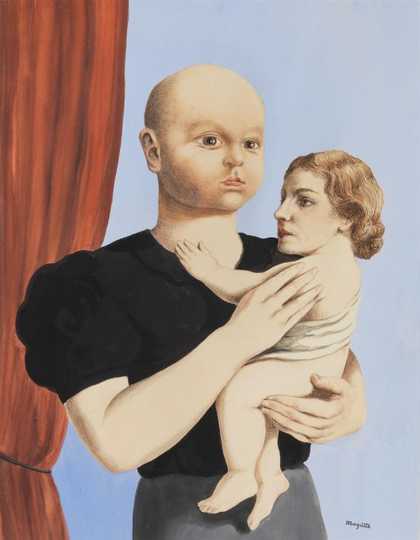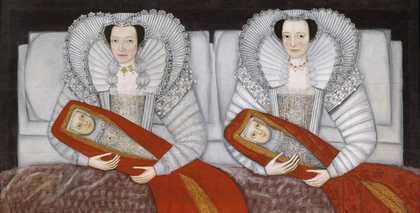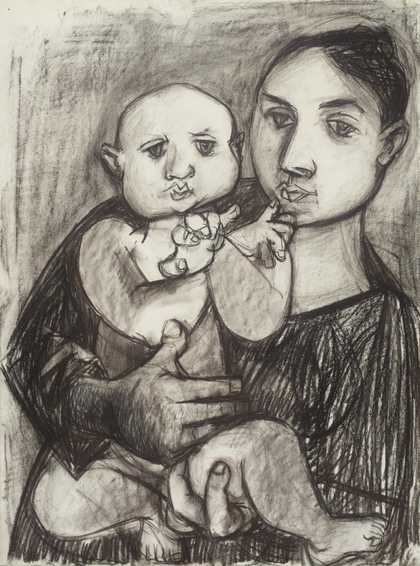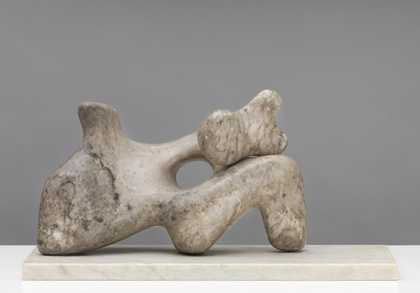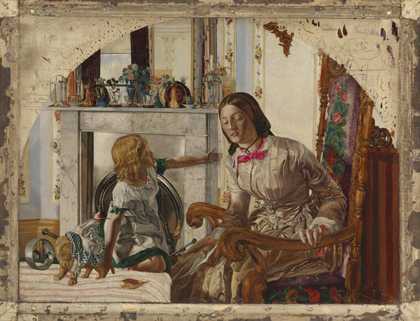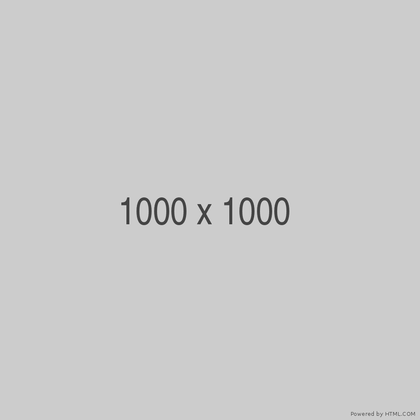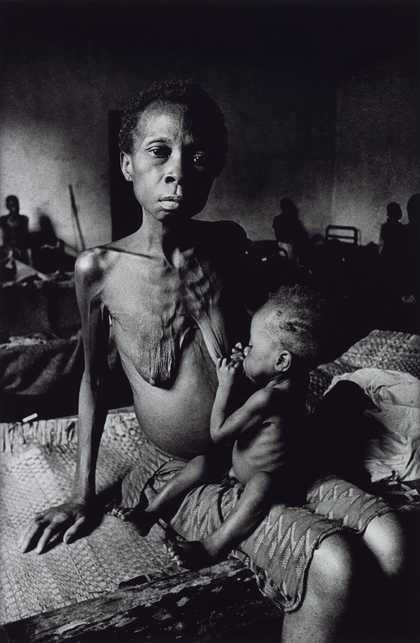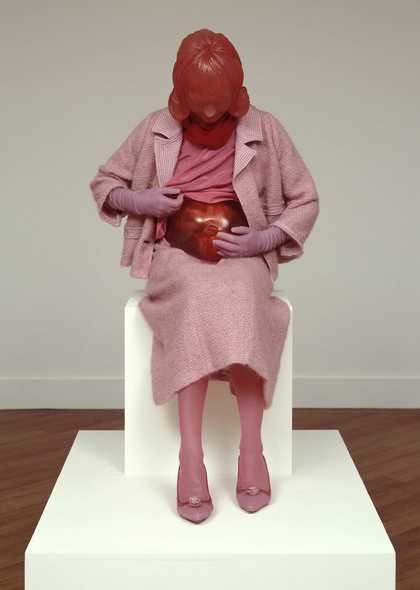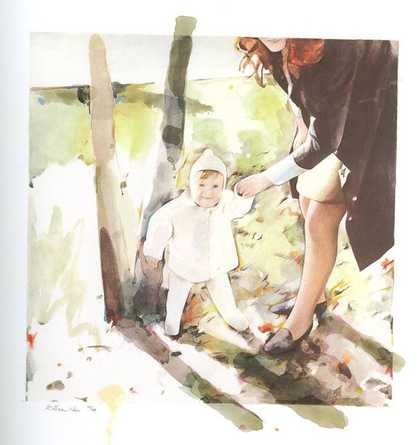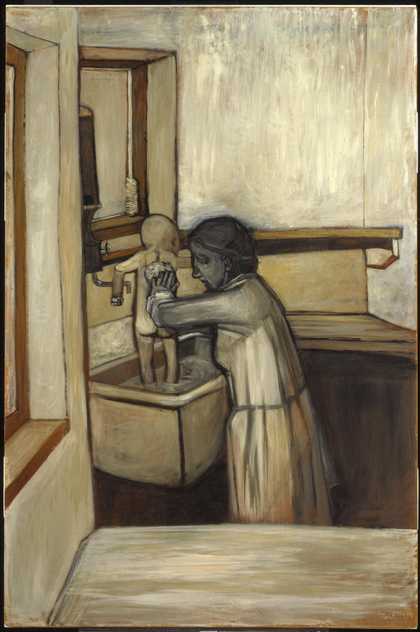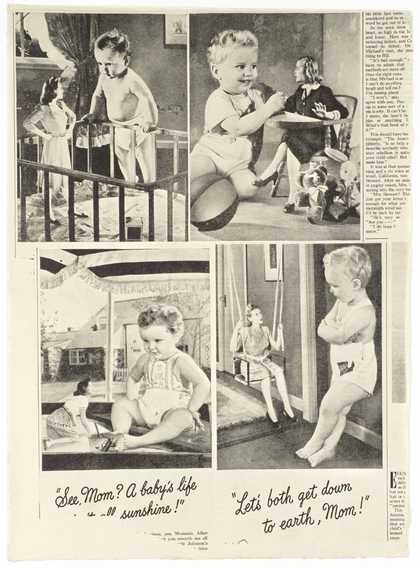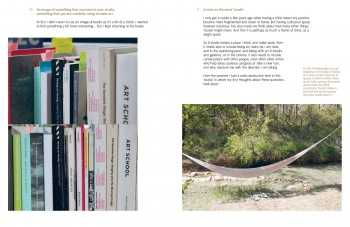The slideshow above shows a selection of artworks that show the close relationship between mother and child. Some, like Don McCullin’s photograph of a starving mother, show the strength of this bond through hard times. Other artists have made use of composition to emphasize the nature of this close relationship. Mothers with their babies almost identically repeat poses in The Cholmondeley Ladies. Barbara Hepworth uses the arrangement of large and small abstract elements to suggest the mother and child theme. René Magritte and Eduardo Paolozzi have reversed the natural roles to create humorous (but unsettling) versions of the theme.
Take a closer look at…
Rene Dijkstra’s new mothers
Rineke Dijkstra turns the all-seeing lens of her camera onto very new mothers. Her series of portraits of women was made shortly after the mothers gave birth. We see signs of their recent ordeal – the medical pants and sanitary towel, a trickle of blood, a caesarean scar. The women appear proud and happy. They hold their new babies turned away from the camera, protectively pressed against their bodies. Dijkstra is interested in photographing people at a time when they do not have everything under control. She uses the formally posed, full-length portrait to try to reveal something intimate. There are emotions behind the mask of the face and the body’s pose. The bright lights and details the camera picks up makes the women as vulnerable as the tiny babies they hold.
Mary Kelly’s Post-partum Document
Mary Kelly documented her relationship with her son over a period of six years. She explores the contradictions between being an artist and a mother. Kelly describes the work as exploring differences between ‘my lived experience as a mother and my analysis of that experience’. To make the work, Kelly recorded and reflected on a number of conversations with her son. After this, she allowed him to scribble across her carefully documented texts.
Louise Bourgeois’s Maman
In her sculpture Maman (French for ‘mother’) Louise Bourgeois explores the often complicated nature of mother and child relationships. She reflects on and how these relationships effect our identity. The huge spider towering on its pointy knobbly legs is quite frightening. It also seems very powerful and protects a sack of eggs hanging beneath her.
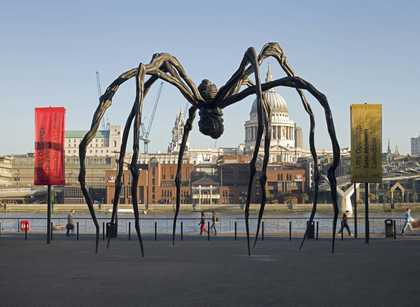
Louise Bourgeois Maman 1999
Photograph: Marcus Leith and Andrew Dunkley, Tate Photography
© The estate of Louise Bourgeois
Bourgeois has spoken of the positive attributes a spider may have:
The Spider is an ode to my mother. She was my best friend. Like a spider, my mother was a weaver. My family was in the business of tapestry restoration, and my mother was in charge of the workshop. Like spiders, my mother was very clever. Spiders are friendly presences that eat mosquitoes. We know that mosquitoes spread diseases and are therefore unwanted. So, spiders are helpful and protective, just like my mother.
Find out more about Bourgeois’ ideas and inspiration in this video made at the time of her major retrospective at Tate Modern in 2007.
Ilya Kabakov’s Labyrinth (My Mother’s Album)
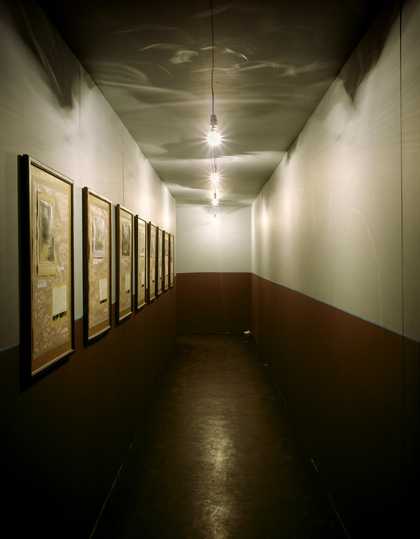
Ilya Kabakov
Labyrinth (My Mother’s Album) (1990)
Tate
Ilya Kabakov created this work soon after his mother’s death. Like Bourgeois, his memories are ambiguous. Fond memories of his mother mingle with a sense of anxiety. He uses the work to explore his own identity as well as pay tribute to his mother. Labyrinth (My Mother’s Album) is a large installation made up of a series of narrow corridors arranged in maze-like double spiral. Kabakov has described his personal memories of corridors as places of boredom. Collages of printed images, photographs and texts are hung along the walls of the corridors. They are all glued onto old-fashioned pink patterned wallpaper. The text in the panels, written in Russian, recount the memoirs of Kabakov’s mother Bertha Solodukhina. The story explains her tragic life in simple language. Happy and unhappy memories are mixed together.
Damien Hirst’s Mother and Child Divided
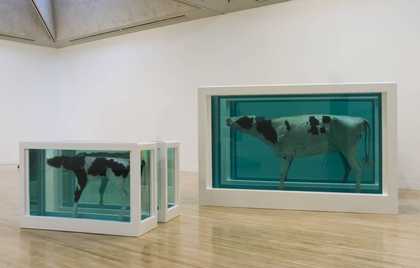
Damien Hirst
Mother and Child (Divided) (exhibition copy 2007 (original 1993))
Tate
Damien Hirst presents the opposite of the traditional joyful unity of mother and baby. This mother and child are not only forever separated from one another, but have also been cut in half. The Holy Mother and Child is traditionally the centrepiece of catholic devotion. Hirst often deals with big themes like mortality and religion in his work. He has brought these together in his Mother and Child Divided. Like Bourgeois’s Maman, Hirst’s work is ambiguous. The imagery of a cut-in-half cow and her calf should be horrific. But there is something strangely beautiful and moving about the piece. As Hirst says:
You cut it in half, and you can see what’s on the inside and outside simultaneously. It’s beautiful…It’s sad but you feel more … a viewer should be intrigued. The work should attract you and repel you at the same time … cows are the most slaughtered animals ever … I see them as death objects. Walking food … What’s sad is that if you look at my cows cut up in formaldehyde, they have more personality than any cows walking about in fields.
Tracey Moffatt’s Scarred for Life series
Sadly not all mother and child relationships involve tenderness or admiration. Tracey Moffatt’s Scarred for Life series explores abusive relationships. She references memories from her own childhood. The format of the works are like photo spreads from the American magazine Life. The photographs are haunting. They either show or suggest violence or vulnerability. They have captions that hint at the traumatic stories behind the pictures. Moffatt has commented:
A person can make a passing comment to you when you are young and this can change you forever. You can be ‘scarred for life”.

